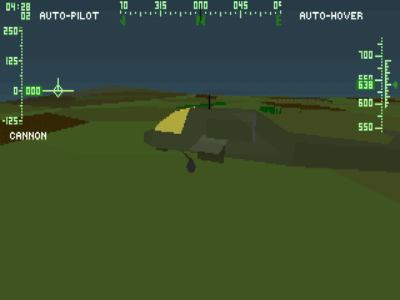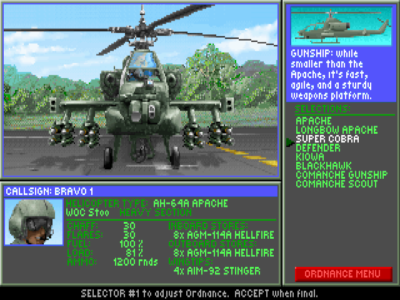
Gunship 2000
Written by: Stoo
Date posted: December 1, 2001
- Genre: Simulation
- Developed by: Microprose
- Published by: Microprose
- Year released: 1991
- Our score: 6
Another parade of US airborne hardware, this was the sequel to the Neolithic helicopter sim Gunship. It features a full career mode, eight different types of army helicopter and all manner of hapless Russian vehicles to rain missiles on.
First point – helicopters are pretty damn complex to fly. In a sim you might think you’ve got the hang of it when you can make it round a tower and back to the hangar, but just try flying in a combat situation; hugging the ground, evading missiles etc. Many would-be propellor-heads have surely found their first mission ending with their Apache Gunship sticking artfully out of the side of a house, tank or hill. Thankfully in GS2000 there’s an option to switch between simplified and ‘realistic’ flight model, and being incompetent I usually pick the former. In simple terms this means the up-down controls are separated from the forward-backwards-turn controls. Newbies thus don’t need to worry about spiraling into a tree twenty feet from take off, plus you can carry out such daft stunts as flying through railway tunnels.
Okay, so let’s assume you’ve managed to get you helicopter off the ground. The question is, can a flight sim this old still hold our interest? Well, I can safely say that for those of you who have always fancied a bit of a ramble in the countryside in an airborne tank-killer, there is still some appeal to GS2000. The combat itself usually makes for quite a fun romp through the countryside, as you fling missiles at hapless enemy tanks, carry out ‘pop-up’ attacks from behind hills, or skim the ground at treetop level avoiding SAMs. The range of choppers and weaponry is suitably impressive, with gunships, scouts and a transport helicopter available. They all seem to handle the same in the air, which seems a bit wrong, maybe that’s because I’m playing on incompetent mode. There is however considerable difference in what weaponry each can carry. Sometimes you specifically need a scout or a transport chopper, otherwise you have a free reign as to what you pack along. You can never go too far wrong with a few heavily armed Apaches for dealing death, although the manual states you’ll get more credit for accomplishing the same tasks in more lightweight helicopters.

Of all the helicopters featured in the game, the Apache is the most powerful.
You see, as per usual for flight sims success brings shiny rewards. Firstly medals are handed out for particularly successful missions, or at least that’s the theory. I must say it seems a bit random to me, and I’m not sure what you have to do to receive a really top-notch award. Oh, and as this is the US military, you can receive a medal just for managing to get yourself wounded (cynicism aside, I suppose it’s good for morale). More important of course is the issue of promotions, which are given for continuous good performance. You begin as a lowly warrant officer flying missions by yourself, but unless you’re really crap you will at some point be offered a commission. This basically means you become an officer and have four wingmen under your command, who accompany you on your m
This sounds like a grand idea; sadly their capabilities are rather limited. All your wingmen can actually do is follow a set path designated on the map, or otherwise follow you in very close formation. They also seem to ignore all enemy targets apart from the mission objectives, thus requiring you to clear a path for them through the anti-aircraft defences. Okay, this was 1991 and I wouldn’t expect the AI to do anything really cunning, but surely a more advanced level of self-preservation would have been possible. However there is another advantage to promotion – when you reach the higher ranks you are given access to the two most powerful choppers, the Comanche and the Longbow Apache.

Choose your payload. Basic ockets come in greater quanities, but guided missiles are easier to use.
Apart from single missions there’s a semi-dynamic campaign mode. Missions are randomly generated and the events of one doesn’t directly affect the next but succeeding in a number of them in succession results in a victorious campaign, whilst messing up repeatedly may mean the war is lost for your side. You can sign up for as many single missions or campaigns as you wish until you either die, complete 50 missions in total, or get promoted past Colonel.
Overall the game managed a pretty good balance between realism and entertainment value. For the time it was quite a convincing simulation of gunship action (with a medium-sized brick of a manual detailng the mechanics of helicopter flight and combat). Nowadays GS2000 has been entirely outclassed by modern sims in terms of details, graphics and physics model, but it’s still a fun introduction to the genre. If you’re interested in a retro-gaming chopper session from the early days of the genre, it’s really a choice between this, the slightly older LHX or Novalogic’s rather arcadey Comanche (starring the infamous voxels).


 Posts
Posts